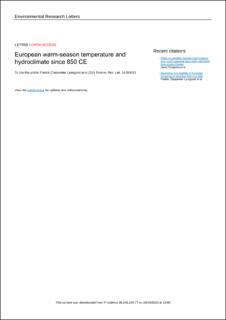| dc.contributor.author | Ljungqvist, Fredrik Charpentier | |
| dc.contributor.author | Seim, Andrea | |
| dc.contributor.author | Krusic, Paul J. | |
| dc.contributor.author | Gonzalez-Rouco, Jesus Fidel | |
| dc.contributor.author | Werner, Johannes | |
| dc.contributor.author | Cook, Edward R. | |
| dc.contributor.author | Zorita, Eduardo | |
| dc.contributor.author | Luterbacher, Jürg | |
| dc.contributor.author | Xoplaki, Elena | |
| dc.contributor.author | Destouni, Georgia | |
| dc.contributor.author | Garcia-Bustamante, Elena | |
| dc.contributor.author | Aguilar, Camilo Andres Melo | |
| dc.contributor.author | Seftigen, Kristina | |
| dc.contributor.author | Wang, Jianglin | |
| dc.contributor.author | Gagen, Mary H. | |
| dc.contributor.author | Esper, Jan | |
| dc.contributor.author | Solomina, Olga | |
| dc.contributor.author | Fleitmann, Dominik | |
| dc.contributor.author | Büntgen, Ulf | |
| dc.date.accessioned | 2021-02-24T09:56:26Z | |
| dc.date.available | 2021-02-24T09:56:26Z | |
| dc.date.created | 2020-03-16T17:13:09Z | |
| dc.date.issued | 2019 | |
| dc.identifier.issn | 1748-9326 | |
| dc.identifier.uri | https://hdl.handle.net/11250/2729998 | |
| dc.description.abstract | The long-term relationship between temperature and hydroclimate has remained uncertain due to the short length of instrumental measurements and inconsistent results from climate model simulations. This lack of understanding is particularly critical with regard to projected drought and flood risks. Here we assess warm-season co-variability patterns between temperature and hydroclimate over Europe back to 850 CE using instrumental measurements, tree-ring based reconstructions, and climate model simulations. We find that the temperature–hydroclimate relationship in both the instrumental and reconstructed data turns more positive at lower frequencies, but less so in model simulations, with a dipole emerging between positive (warm and wet) and negative (warm and dry) associations in northern and southern Europe, respectively. Compared to instrumental data, models reveal a more negative co-variability across all timescales, while reconstructions exhibit a more positive co-variability. Despite the observed differences in the temperature–hydroclimate co-variability patterns in instrumental, reconstructed and model simulated data, we find that all data types share relatively similar phase-relationships between temperature and hydroclimate, indicating the common influence of external forcing. The co-variability between temperature and soil moisture in the model simulations is overestimated, implying a possible overestimation of temperature-driven future drought risks. | en_US |
| dc.language.iso | eng | en_US |
| dc.publisher | IOP Publishing | en_US |
| dc.rights | Navngivelse 4.0 Internasjonal | * |
| dc.rights.uri | http://creativecommons.org/licenses/by/4.0/deed.no | * |
| dc.title | European warm-season temperature and hydroclimate since 850 CE | en_US |
| dc.type | Journal article | en_US |
| dc.type | Peer reviewed | en_US |
| dc.description.version | publishedVersion | en_US |
| dc.rights.holder | Copyright 2019 The Author(s). | en_US |
| dc.source.articlenumber | 084015 | en_US |
| cristin.ispublished | true | |
| cristin.fulltext | original | |
| cristin.qualitycode | 1 | |
| dc.identifier.doi | 10.1088/1748-9326/ab2c7e | |
| dc.identifier.cristin | 1801905 | |
| dc.source.journal | Environmental Research Letters | en_US |
| dc.source.40 | 14 | |
| dc.source.14 | 8 | |
| dc.identifier.citation | Environmental Research Letters. 2019, 14 (8), 084015. | en_US |
| dc.source.volume | 14 | en_US |
| dc.source.issue | 8 | en_US |

